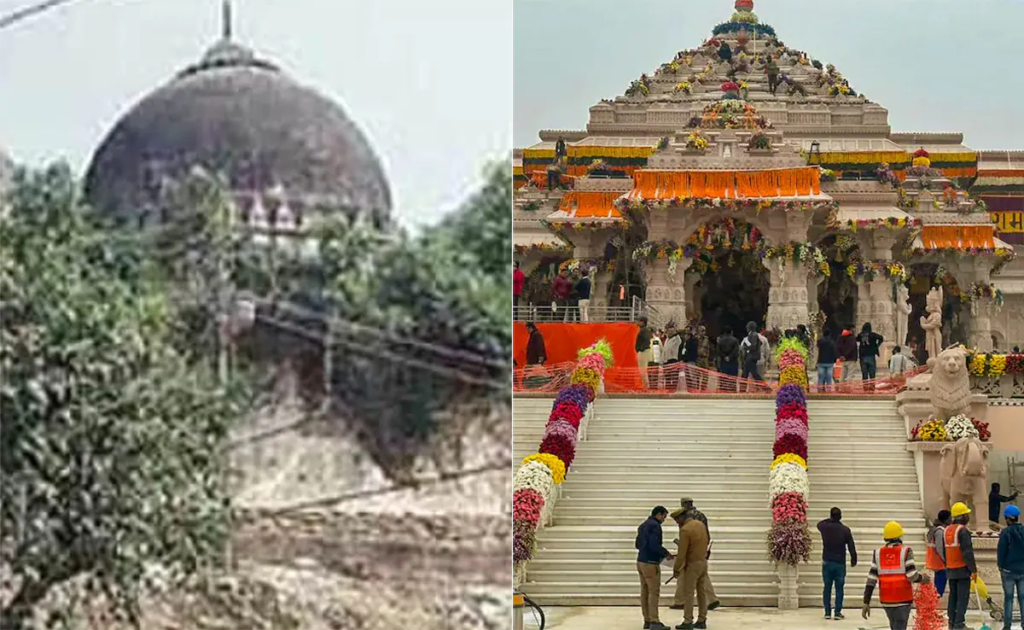Explained: From 1528 To 2024, A 500-Year Timeline
Explained-Introduction:
Explained-The grand inauguration of the Ayodhya Ram Temple on January 22, 2024, was a momentous occasion witnessed by Prime Minister Narendra Modi, religious leaders, politicians, and Bollywood celebrities. As the nation celebrated the realization of a centuries-old dream, this comprehensive exploration delves into the intricate 500-year timeline leading to the construction of the Ayodhya Ram Temple. With nearly 400 pillars, 44 doors, and a brand new idol of Lord Ram, the temple stands as a symbol of unity, faith, and a resolution to a long-standing dispute.

Explained-Chapter 1: 1528 – Babri Masjid’s Origin
The roots of the Ram Temple movement can be traced back to 1528 when Mir Baqi, a commander of Mughal emperor Babur, oversaw the construction of the Babri Masjid. This act laid the foundation for decades of debate and clashes between Hindu and Muslim communities, as the belief that the mosque was built on the ruins of a Hindu temple became deeply embedded in the narrative.
Explained-Chapter 2: 1751 – A Maratha Claim
In 1751, the Marathas sought control over Ayodhya, Kashi, and Mathura, as documented by writer and former Rajya Sabha MP Balbir Punj in his book ‘Tryst with Ayodhya: Decolonisation of India.’ This historical claim set the stage for numerous contentions that would shape the dynamics of the Ayodhya dispute.
Explained-Chapter 3: 1858 – Nihang Sikhs’ Demand
The year 1858 witnessed an attempt by Nihang Sikhs to claim Babri Masjid as Lord Ram’s birthplace. This early incident marked the beginning of the struggle for control over the disputed site, foreshadowing conflicts to come. The Supreme Court’s 2019 landmark ruling acknowledged the historical significance of this event.
Explained-Chapter 4: 1885 – The First Legal Claim
In 1885, Raghubar Das, a priest of the Nirmohi Akhara, filed the first legal suit seeking permission to build a temple on the outer courtyard of the mosque. Though dismissed, this legal action set a precedent that kept the dispute alive. Meanwhile, the British administration marked the site with a fence, designating separate areas of worship for Hindus and Muslims for almost 90 years.
Explained-Chapter 5: 1949 – ‘Ram Lalla’ Idols Inside Babri Masjid
December 22, 1949, witnessed a significant development as ‘Ram Lalla’ idols were placed inside the Babri Masjid, escalating religious sentiments and initiating legal battles over ownership. The Hindu claim that the idols “appeared” inside the mosque led to the property dispute going to court for the first time.
Explained-Chapter 6: 1950-1959 – Legal Suits Multiply
The subsequent decade witnessed a surge in legal suits, with Nirmohi Akhara seeking rights to worship the idols and the Sunni Central Waqf Board seeking possession of the site. The legal quagmire deepened, creating a complex web of competing claims and legal battles.
Chapter 7: 1986-1989 – Babri Masjid Locks Opened
In 1986, during the Rajiv Gandhi-led Congress government, the locks of the Babri Masjid were controversially opened, allowing Hindus to worship inside. This decision fueled tensions and became a pivotal moment in the Ram Janmabhoomi narrative. The Vishwa Hindu Parishad (VHP) set a deadline for the construction of the Ram Mandir in 1990, escalating demands for a temple. This period also witnessed the beginning of a Rath Yatra by BJP veteran LK Advani, marking a seismic shift as political leaders mobilized support for the ‘liberation’ of Ram Janmabhoomi.
Chapter 8: 1990 – Rath Yatra and Failed Demolition Attempt
Against the backdrop of the Mandal Commission’s implementation and rising political tensions. turning point in the movement, shaping the course of future events.
Chapter 9: 1992 – The Infamous Demolition
The year 1992 witnessed a climactic event with the demolition of the Babri Masjid by Hindu activists, despite assurances to the Supreme Court. The cataclysmic event and the riots that followed changed the landscape of Indian politics forever, leaving an indelible mark on the nation’s collective memory.
Chapter 10: 1993-1994 – Post-Demolition Riots
The PV Narasimha Rao-led Central government’s acquisition of the disputed area faced legal challenges, leading to a Supreme Court ruling in 1994 that upheld the acquisition, further entrenching the state’s involvement in the matter.
Chapter 11: 2002-2003 – ASI’s Excavation and Allahabad High Court Hearing
The legal battle continued, with each side presenting historical and archaeological evidence to bolster their respective claims.
Chapter 12: 2009-10 – Liberhan Report Submission
After 399 sittings over 16 years, the Liberhan Commission submitted its report in June 2009, revealing intricate details of the Babri Masjid demolition and implicating key leaders, including LK Advani, Atal Bihari Vajpayee, and other BJP leaders. The submission of the report marked a crucial point in the inquiry, nearly 17 years after its commencement.
Chapter 13: 2010 – Allahabad High Court’s Verdict
However, the decision faced appeals and further legal challenges, prolonging the resolution of the Ayodhya dispute.
Chapter 14: 2019 – Supreme Court’s Historic Judgment
This judgment marked a pivotal moment in the centuries-old dispute, providing a legal basis for the construction of the Ram Temple.

This makes some good ideas-but I notice you could be lacking clarity. I would like to see you write more about this, because you are an excellent blogger and I get immense value from reading your posts.
Thank you so much for the feedback, we will work on your feedback and improve our quality/clarity.